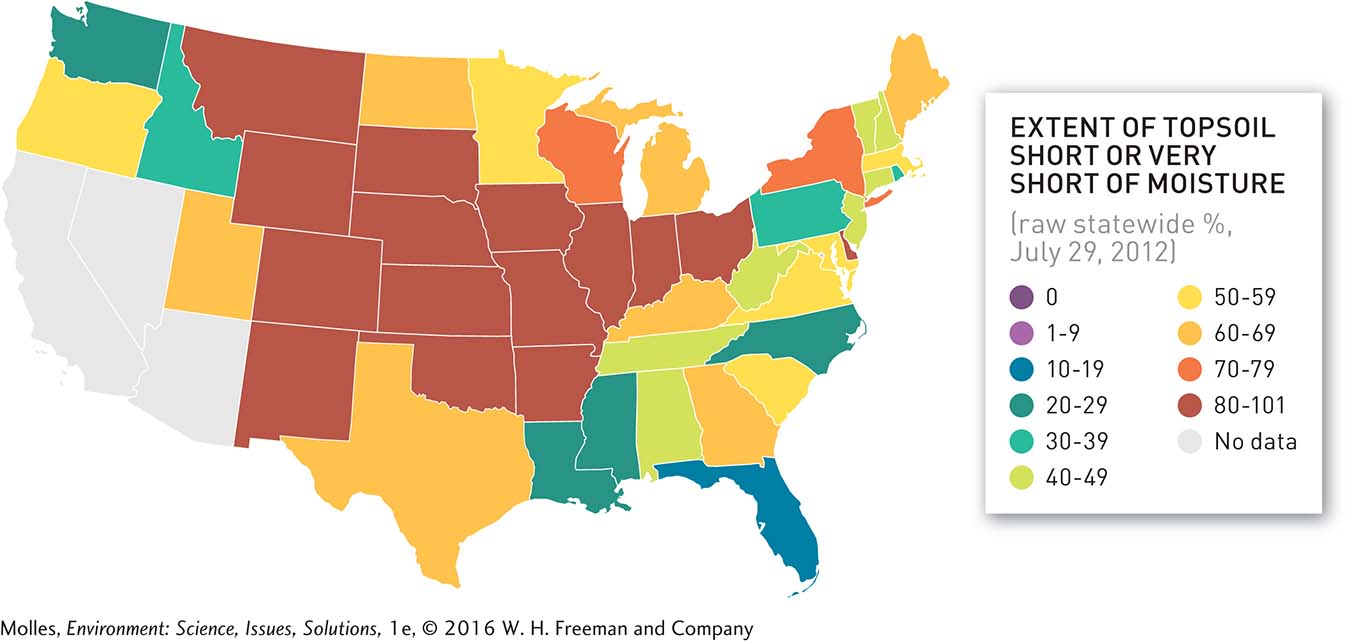14.8 Climate change can lead to a wide range of societal costs
Climate scientists have been predicting that a warmer Earth will be one in which there are many more extreme weather events, including stronger winds, more frequent torrential rains and floods, and higher temperatures during heat waves.
Take, for instance, those scorching hot days of summer, when it’s impossible to get anything done without the air conditioning on full blast. Not only are these scorchers getting more common, they are affecting a wider geographic area. James Hansen of NASA’s Goddard Institute for Space Studies compared the 30 years from 1951 to 1980, which were used as a reference period, to the most recent decade of 2001 to 2011. In the past, only about one-
449
One of the most serious societal consequences of a warming Earth comes not from the heat itself, but from changes in the way water moves through our landscapes, farmland, and ecosystems. Scientists expect an increase in the depth and frequency of droughts, interrupted by short bursts of torrential rains and floods. The first decade of the 21st century was marked by a number of such events, and their economic costs are considerable. A 2010 study from the Pew Trust estimated that the global cost of climate change will range from $5 trillion to $90 trillion by 2100 (Figure 14.30).
450

Disruptions to Agriculture
Rising temperatures will harm our food system, which will already be stretched thin by a growing human population. According to the Food and Agriculture Organization of the United Nations, global food demand will increase by 70% by the year 2050. Meanwhile, the International Food Policy Research Institute has predicted that climate change will result in less food available per capita across the globe than there was in the year 2000.
We are already seeing the impact of extreme heat events on agriculture today. In 2012 the drought in the United States resulted in low levels of soil moisture during the growing season (Figure 14.31 on page 451). Low soil moisture, in turn, reduced areas of healthy corn and soybean production by one-

Droughts also affect livestock farmers. During the 2012 drought in the United States, over half of rangelands and pastures across the country were in poor to very poor condition, forcing many farmers to sell off cattle. High feed prices led to other farmers selling off hogs. Unless agriculture can adapt to a rapidly changing climate, such shortfalls in production will only worsen.
Impacts on Human Health
Extreme heat can be deadly. The summer of 2003 was the hottest one in Europe in the last 500 years. During that heat wave, an estimated 70,000 of people died in 16 countries. The elderly, the infirm, and the poor without adequate air-
Climate change is also predicted to increase the prevalence of certain infectious diseases. For instance, insect-
451
The torrential rains expected from global warming may also raise the risk of water contamination by a variety of infectious diseases, such as Cryptosporidium and toxin-
Think About It
How might people respond to warmer temperatures to make themselves more comfortable in their apartments and offices?
Can you think of how humans might change their diets to cope with changes in agriculture?
14.5–14.8 Issues: Summary
Humans are changing the climate. Led by the findings of Charles Keeling, climate researchers have recorded global increases of CO2 and temperatures.
Rising global temperatures have set in motion many changes to the Earth system, including the loss of Arctic sea ice; melting ice sheets, glaciers, and ice caps; sea level rise; shifting species’ ranges; and the degradation of vital foundation species, such as forest trees and reef-
Earth is experiencing more extreme weather events, such as heat waves, droughts, and intense storms. Such changes have disrupted agriculture, producing lower harvests. Meanwhile, heat waves and extreme weather events have resulted in tens of thousands of premature deaths and the movement of tropical diseases into higher latitudes.